
Selasphorus is a genus of hummingbirds from Middle and North America.

The amethyst woodstar is a species of hummingbird in tribe Mellisugini of subfamily Trochilinae, the "bee hummingbirds". It is found in every mainland South American country except Chile and Uruguay and has been recorded as a vagrant on Trinidad.
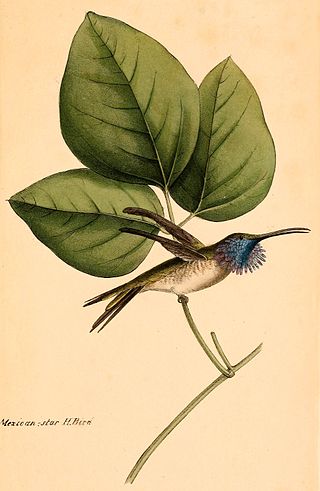
Calothorax is a genus of birds in the hummingbird family Trochilidae.

The gorgeted woodstar is a species of hummingbird in tribe Mellisugini of subfamily Trochilinae, the "bee hummingbirds". It is found in Colombia, Ecuador, and Venezuela.

The rufous-shafted woodstar is a species of hummingbird in tribe Mellisugini of subfamily Trochilinae, the "bee hummingbirds". It is found in Colombia, Trinidad and Tobago, and Venezuela.

The blue-headed hummingbird is a species of hummingbird in the "emeralds", tribe Trochilini of subfamily Trochilinae. It is found only on the islands of Dominica and Martinique in the Lesser Antilles.
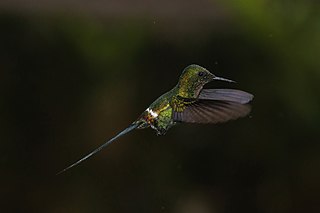
Discosura is a genus of South and Central American hummingbirds in the family Trochilidae. The thorntails are sometimes placed in the genus Popelairia, leaving Discosura for the racket-tipped thorntail. On the contrary, some have argued for merging this genus into Lophornis, which they overall resemble, except for the highly modified tail-feathers of the males.

The caribs are a genus, Eulampis, of hummingbirds in the family Trochilidae. The genus contains two species, both of which are endemic to the islands of the Caribbean. The genus name comes from the Ancient Greek word eulampēs meaning 'bright shining'.
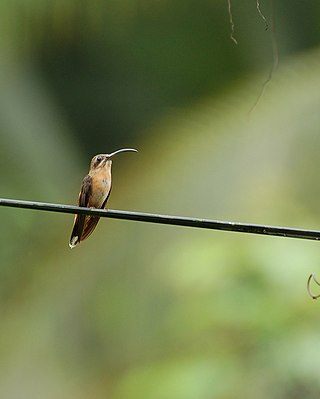
Glaucis is a genus of hummingbird in the family Trochilidae.
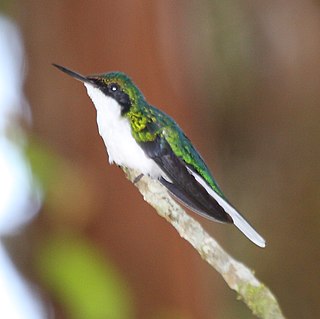
Heliothryx is a genus of hummingbird in the family Trochilidae. The genus is assigned to the subfamily Polytminae which is sometimes referred to by the informal name "mangoes".

Hylocharis is a genus of hummingbirds, in the family Trochilidae. It contains two species that are both found in South America.
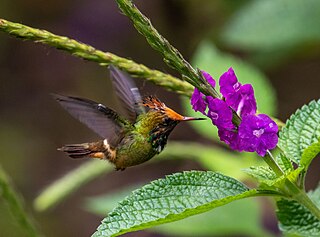
Lophornis is a genus of hummingbird in the family Trochilidae. These are all tiny birds, ranking among the smallest hummingbirds. No species exceeds 9 cm (3.5 in) and most are under 7.5 cm (3.0 in) in total length, weighing 3 grams or less. The male coquettes are noted from their outlandish, colorful crests and markings, the females being more subdued.

Mellisuga is a genus of hummingbirds in the family Trochilidae. They are notable for being the first and second smallest bird species in the world.

The metaltails are a group of hummingbirds in the genus Metallura. The species are distributed along the Andes.

Woodnymphs are hummingbirds in the genus Thalurania. Males are green and violet-blue, while females are green with white-tipped tails and at least partially whitish underparts. Both sexes have an almost straight, entirely black bill and little or no white post-ocular spot. They are found in forest and tall second growth. The species in this genus are almost entirely allo- or parapatric, and a species is present virtually everywhere in the tropical humid Neotropics.
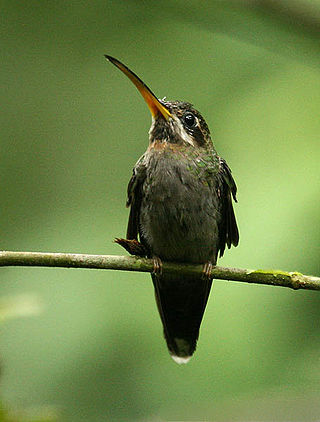
The barbthroats are a genus Threnetes of South American hummingbirds in the family Trochilidae.

The streamertails are hummingbirds in the genus Trochilus, that are endemic to Jamaica. It is the type genus of the family Trochilidae. Today most authorities consider the two taxa in this genus as separate species, but some continue to treat them as conspecific, in which case scitulus is a subspecies of T. polytmus. A wide range of common names apply to this combined species, including green-and-black streamertail, Jamaican streamertail or simply streamertail. The name streamertail is a reference to the greatly elongated rectrices of the males.

The rufous-gaped hillstar, formerly included in the white-tailed hillstar, is a species of hummingbird in the "brilliants", tribe Heliantheini in subfamily Lesbiinae. It is found in Colombia and Ecuador.
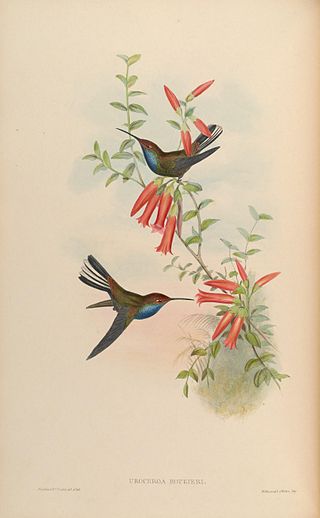
Urochroa is a genus of hummingbird containing two recently-split species.

Philodice is a genus of hummingbirds in the tribe Mellisugini and family Trochilidae.



































